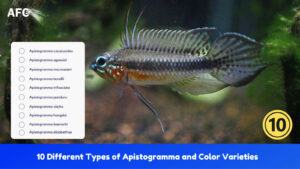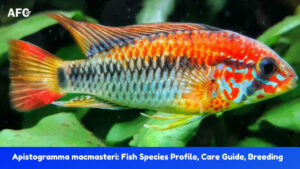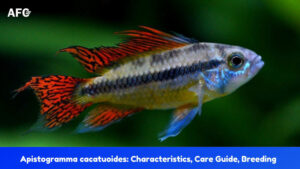The exquisite reticulated hillstream loach is becoming more and more popular among aquarists.
Sure, they’re a fairly recent introduction to the aquarium trade, but the popularity of reticulated hillstream loaches is definitely on the rise.
Here’s why:
First, these oddball fish are one of the coolest-looking loaches you can get your hands on. Their unique body shape and patterning easily make them stand out from other standard loaches in the aquarium. When I first saw them in a local fish store, I was immediately hooked.
They’re also easy to care for and stay small. Reticulated hillstream loach care is pretty something that even beginner fishkeepers can handle.
And last and most importantly, this fish is an amazing algae eater that can help to get the algae outbreak under control.
However, like other hillstream loach species, they do have some specific needs that you need to be aware of.
So, if you’re thinking about getting one (or a group) of these little fish for your aquarium, read on. In this article, I’ll go over everything you need to know about reticulated hillstream loach care.
Species Profile
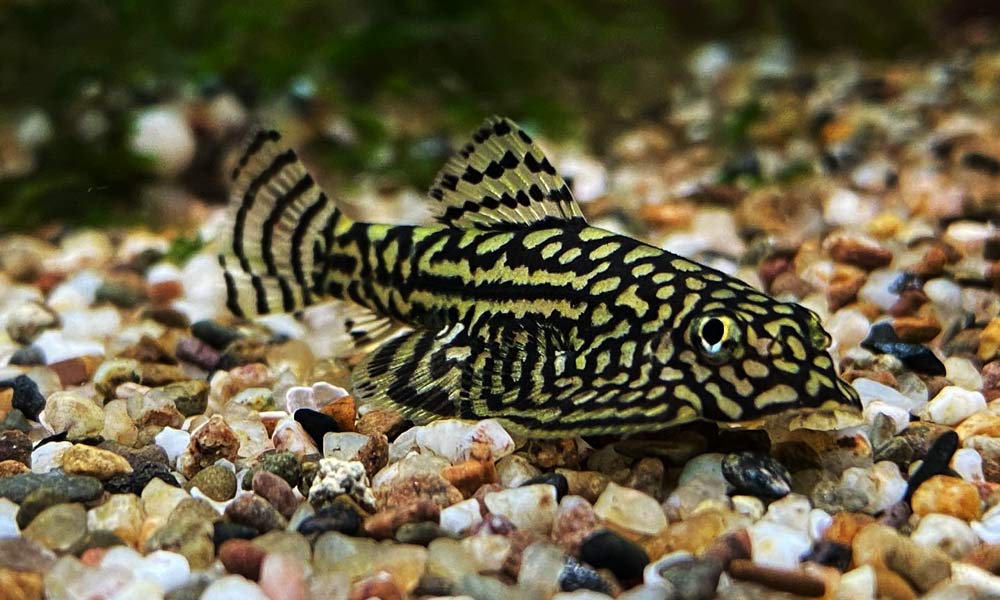
Reticulated hillstream loaches (Sewellia lineolata), also known as gold ring butterfly sucker and tiger hillstream loach, are one of the most common hillstream loaches in the aquarium hobby.
There are 202 species in the hillstream loaches (Balitoridae) family. Most species are rheophilic, meaning that they inhabit moderate to swift currents thanks to their flat, streamlined bodies and evolved ventral fins used as suction cups that help them stay in place against the strong currents, particularly these Sewellia species.
Native to Vietnam and Laos, Reticulated hillstream loaches are found in fast-flowing, highly oxygenated small streams with submerged plants, as well as in larger rivers where current velocity may exceed 1 m/sec.
In their natural habitat, they prefer to live in clear water bodies with high dissolved oxygen levels. In such an environment, rich biofilms covering the submerged surfaces can provide the residents shelter and abundant nutrients.
| Scientific Name: | Sewellia lineolata |
| Common Name: | Reticulated Hillstream Loach, Gold ring butterfly sucker, Tiger Hillstream Loach |
| Care Level: | Beginner |
| Origin: | Asia |
| Lifespan: | 8 to 10 years |
| Max Size: | 2 to 3 inches (5 to 7.5 cm) |
| Temperature: | 68ºF to 75ºF (20-23.8°C) |
| PH: | 7.0-7.8 |
| Water hardness: | 10-15 dGH |
| Diet: | Omnivorous |
| Minimum Tank Size: | 20 gallons |
| Temperament: | Peaceful |
Lifespan
Reticulated hillstream loaches have a lifespan of 8-10 years in captivity. Like all fish, this number can be lower if they’re not kept in optimal conditions.
As with these fish, providing them with clean, well-oxygenated water with a fast flow whilst maintaining water parameters in good shape will help them reach their maximum lifespan potential. We’ll get into the details of how to do that a little later on.
Appearance
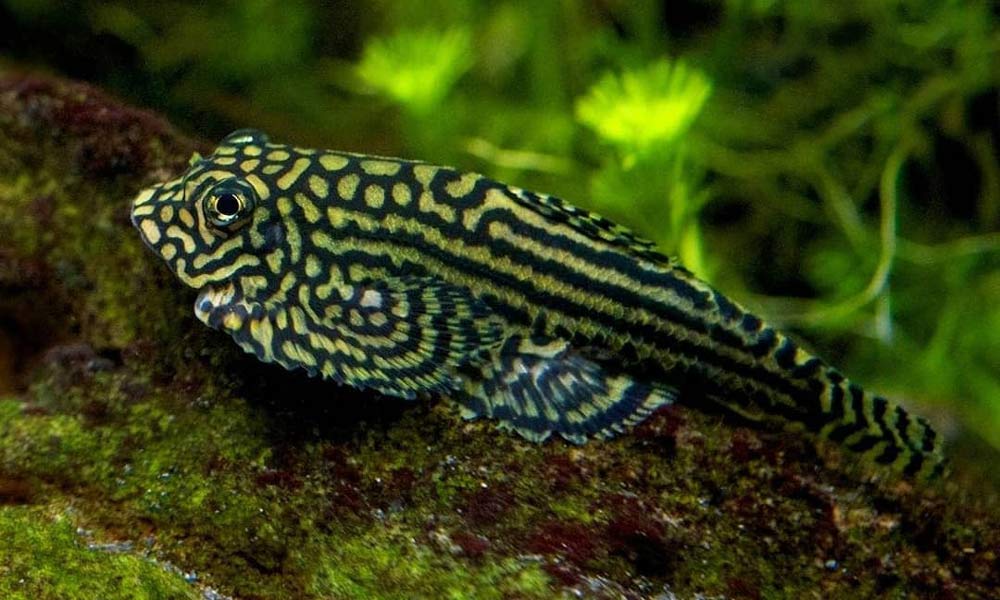
It’s not hard to see why reticulated hillstream loaches are on the rise in popularity. These fish are absolutely unique and beautiful!
First things first, don’t confuse them with Cobitidae and Loricariids. The former is the true loach family that contains around 260 species, and they have similar barbels around the mouth. The latter, on the other hand, are a group of freshwater fish that share certain traits with reticulated hillstream loaches but are actually suckermouth armored catfishes.
Also, these oddballs are often mistaken for the smallest freshwater stingray because of their very similar body shapes.
Now that we’ve got that out of the way, let’s get back to reticulated hillstream loaches. They have a reticulated (or net-like) pattern on their bodies that can vary in intensity from light gold to dark brown. This intricate reticulation is what gives them one of their other common names, the gold ring butterfly sucker.
Look closely; you will notice 3-5 pronounced longitudinal lines on both sides of the body. Pelvic and pectoral fins are also covered with bold submarginal stripes. The stripes tend to be linear on the caudal fin. The rest of the body is accented with these intricate patterns.
They have a streamlined body that is built perfectly to withstand fast currents with the help of their well-developed and unique ventral fins. To assist them further in staying anchored against the fast current, their evolved fins feature needle-like fin spines.
Otherwise, like many other catfish, they have a flattened belly and a smaller sucker mouth.
Males Vs. Females
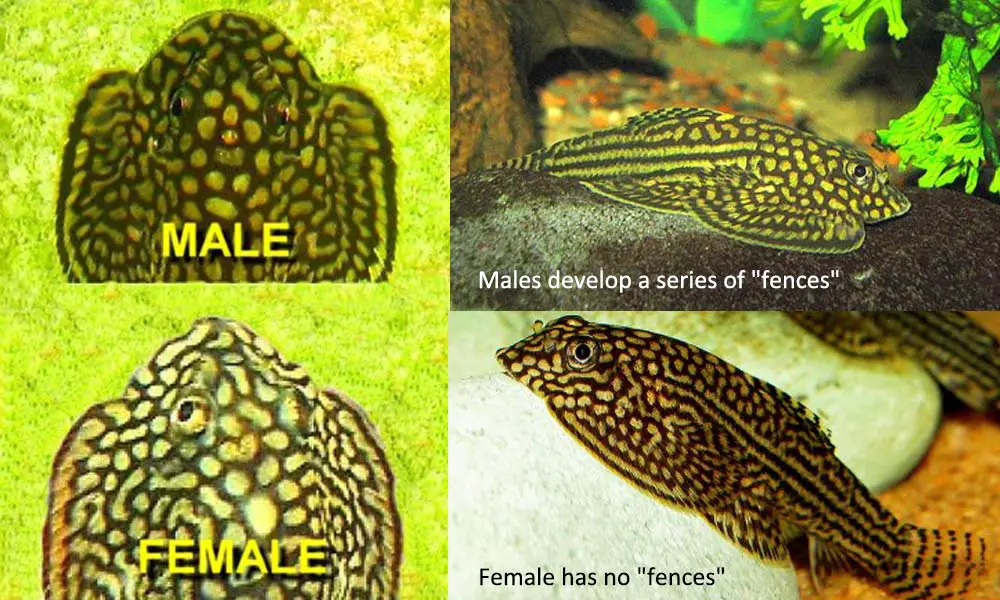
The reticulated hillstream loach (Sewellia lineolata) is sexually dimorphic, so it’s pretty easy to distinguish between males and females.
As with many other species of fish, female reticulated hillstream loach tends to be larger and broader than males, whereas the males are slender when viewed from above.
Sexual maturity males develop a much squarer snout, and their pectoral fins run almost at right angles to the body, while the pectoral fins on females are positioned at a more rounded or softer angle.
You’ll have to pay attention to their upper surface (the surface of the head) and the edge of their first few pectoral-fin rays, where mature males will develop small tubercules called ‘fences’ in the hobby. These structures are much smaller or absent in females.
Reticulated Hillstream Loach Size
The standard length of reticulated hillstream loach is around 2 to 3 inches (5 to 7.5 cm) when fully grown. Compared to other popular types of loaches, they are quite small.
Reticulated Hillstream Loach Care
The biggest consideration when keeping a reticulated hillstream loach in the home aquarium is providing a high-velocity water flow since these fish require a high level of oxygen.
This is what you find fish keepers talk about most, and for a good reason. They are obligate stream fish, so they require moving water to thrive, and lots of it!
However, that’s not the whole story.
Current & High Oxygenation
In captivity, you’ll never have a chance to see them show their behavior as they would in the wild, owing to their highly adaptable nature.
Theoretically, replicating their natural environment by adding an extra powerhead to return flow from the filter will provide them with everything they need in terms of water movement.
But, you’ll quickly find out that’s not the case. They still tend to spend most of their time congregating near the power-head outlet or around the airstone because of the high oxygen concentration in these areas.
So, what’s the solution?
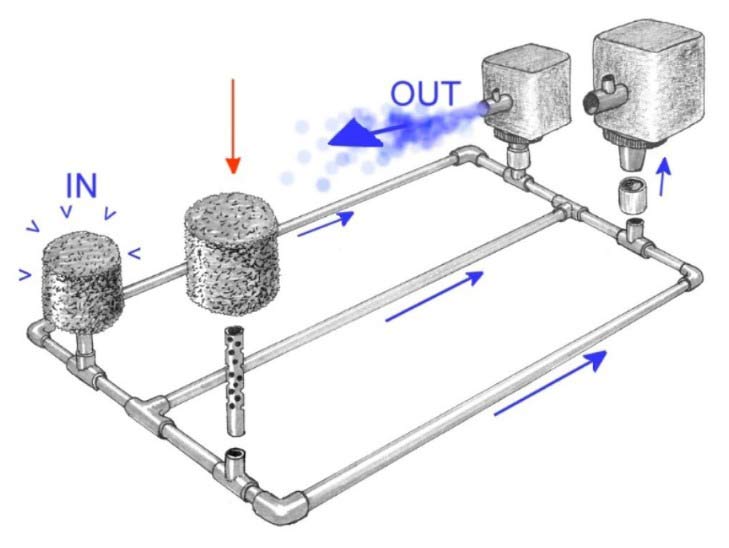
This can be achieved by constructing a river-tank manifold. I must say it looks really cool and would probably be much better than a regular tank setup, simply because it produces the unidirectional flow, like a river. Check out this video or article for more information.
Of course, you don’t have to go this route. Reticulated hillstream loaches are already used to gentle water movement when sold in pet stores, so a sponge filter with an output that produces a moderate flow should do the trick. But it’s something to consider if you really want to provide them with the best possible environment.
Tank Size
Because reticulated hillstream loaches are so small, they don’t need a ton of space. A 20-gallon aquarium is sufficient for a group of 3-4 fish.
But don’t forget that these little oddballs need a lot of water flow, so you might want to take that into account when deciding on tank size. It’s nearly impossible to provide a highly concentrated flow in small tanks, so the next best thing is a longer tank with a large footprint.
Water Conditions
You may already hear from other aquarists that reticulated hillstream loaches are one of the best cold water algae eaters. Generally, cold water can hold more dissolved oxygen than warm water, so this fish may be more susceptible to stress at high temperatures.
As for water parameters, you should aim for the following:
- pH: 7.0-7.8
- Temperature: 68ºF to 75ºF (20-23.8°C)
- Hardness: 10-15 dGH
As with other freshwater fish, reticulated hillstream loaches appreciate good water quality and stable water parameters. So, be sure to perform regular water changes and closely monitor your aquarium for signs of ammonia or nitrite spikes.
Tank Decor
Your goal is re-creating a unique river environment. Choose aquarium décor that will help you achieve that.
Their native habitat – the river beds mainly consist of sand, gravel, and various sized rocks, which provide them with the perfect hiding spots and grazing grounds.
It’s best to use fine gravel with smooth pebbles as substrate. You can mix sand in sheltered areas to provide a more natural look. Decorating them is entirely up to your preference; just make sure to provide a large rock that allows algae to grow on as a grazing spot.
To encourage biofilm/algae growth, you will need moderate to bright lighting, which also encourages tall aquarium plants to grow and improve water clarity. Floating plants are unnecessary as they will block out too much light.
And lastly, don’t forget to include a well-suited lid on the aquarium; you know they have the ability to run up walls and escape.
Food & Diet
In the wild, reticulated hillstream loaches spend most of their time grazing on benthic algae and microorganisms (aufwuchs). Sometimes, they also take on insect larvae that cling to the rocks on an opportunistic basis.
Firstly, you will grow some algae on rocks in the aquarium to provide a constant food source. However, they cannot live on algae alone and will require a varied diet, so make sure to feed them a well-balanced diet.
As for commercial or home-made foods, they will accept the most good quality flake, sinking pellets, and algae wafers. For long-term success with these fish, you should also supplement their diet with vegetable matter and live foods, such as frozen Bloodworm, Brine Shrimp, and blanched kale leaves or zucchini.
Because of their small mouth size, you might want to go for a micro pellet or powder form.
Reticulated Hillstream Loach Tank Mates
Reticulated hillstream loaches are peaceful social species that can be kept singly or in groups of at least 6 fish with other small to medium-sized peaceful community fish of a similar size and share the same water requirements.
Some of the potential reticulated hillstream loach tank mates include:
- Goldfish (Carassius auratus)
- White cloud mountain minnows (Tanichthys albonubes)
- Similarly sized Danios (Danio spp., Devario spp.)
- Freshwater gobies (Rhinogobius spp., Sicyopterus spp.)
- Catfishes (Glyptothorax spp., Akysis spp., Hara spp.)
- Loaches (Nemacheilidae spp., Balitoridae spp., Gastromyzontidae spp.)
- Snails
- Shrimps
In the wild, they tend to be territorial and aggressive towards each other. So, it is best to purchase at least 6 reticulated hillstream loaches to allow them to form their own social hierarchy and feel more secure in the aquarium to show their most interesting, natural behavior. But if you have a larger aquarium, you can increase the number of fish accordingly.
Furthermore, this species comes with a high price tag and may cost around $15 for each fish, so you will need to factor that into your budget as well.
Breeding
Breeding of reticulated hillstream loaches is considered very challenging in captivity, but it is still possible. In order to successfully breed them, you will need to provide them with the perfect breeding conditions, including the river flow tank set up, water parameters, and live foods. Even if you can provide all that, they still might not spawn.
Males are known to perform a unique courtship ritual with fluttering displays and chasing the female, who will watch him for a while and then either accept or reject him. If she accepts him, then the male will ‘dance’ around her in circles and lightly nibble her dorsal. This ritual will last for several minutes before they finally embrace it.
Then the pair will rise up into the water column. You may notice their bodies are rigid and pectoral fins are spread out as they touch ventral to ventral and release their eggs and sperm. It is still unclear how long this embrace lasts or how many eggs are being released as this species is not often bred in captivity.
Young fry often hover close to the external filter, where there is more flow and oxygen. They are very similar to adults in body shape and coloration.
FAQs:
Can you keep reticulated hillstream loaches in a 20 gallon?
They can be kept in small groups in a 20 gallon aquarium, but larger tanks will be more suitable due to their oxygen and water flow requirements.
Where to Buy Reticulated Hillstream Loach?
You can purchase reticulated hillstream loaches from online retailers or specialty fish stores.
Do reticulated hillstream loaches need a filter?
Yes, they need a filter that can provide them with high water flow and oxygenation.
What’s the difference between Reticulated hillstream loach vs. hillstream loach?
The reticulated hillstream loach is a member of the hillstream loach.
What’s the Difference Between Borneo Suckers Vs. Reticulated Hillstream loach?
Borneo Suckers or Borneo Loach (Pangio shelfordii) and Reticulated Hillstream loach (Sewellia lineolata) are two different species, but they require fairly similar care – high water flow, high amount of oxygenation, and colder water temperatures.
Does Reticulated Hillstream loach eat snails?
This species doesn’t eat snails. It only feeds on aufwuchs, a layer of algae, diatoms, and other microorganisms that grow on surfaces in freshwater habitats.
Conclusion
Reticulated hillstream loaches are beautiful, unique freshwater fish that make a great addition to any peaceful community aquarium. These oddball algae eaters are hardy little fish that are relatively easy to care for as long as you provide them with the proper tank setup and water conditions.
If you’re looking for a smaller algae eater for a cold water tank, then reticulated hillstream loaches might be the perfect fit! They do a great job at cleaning algae off flat surfaces and decorations in the tank. Their active, playful personalities will also add a lot of interest and activity to your aquarium.
If there’s anything you think we missed or have any questions, feel free to post them in the comments below. Our mission is to help make fish keeping as fun and easy as possible, so we’re happy to help however we can. Thanks for reading!


